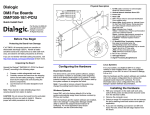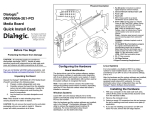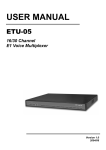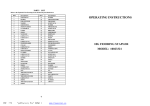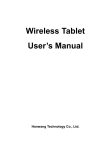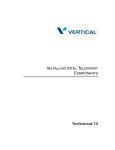Download Dialogic DISI32-EW User's Manual
Transcript
Physical Layout Pinouts for the Power Connector Physical Description 1. CT Bus (H.100) connector 2. SW100 - Rotary switch used to set board identification number 3. Green LED - Power On indicator 4. Yellow LEDs - User-defined #1 and #2 5. Red LED - Out of Service indicator 1 Dialogic® DISI16-EW, DISI24-EW, and DISI32-EW 5 2 6 Copyright © 2006-2007 Dialogic Corporation. All rights reserved. 3 4 5 1 2 3 4 5 6 To AC Power 4 1 Chassis Ground 3 Installation Guide 6 3 12 Connect Breakout Box and Power Supply Power Supply 2 -24/-70 Return PC Sens -24 Volts -24/-70 Return -24 Volts -70 Volts To Telephone Extensions 1. Product Description The product data sheet, available at http:// www.dialogic.com/products/list.asp, provides a functional description as well as information about applications and configurations, features, and technical specifications. Refer to the Release Guide and the online Release Update for your Dialogic system software release to verify that the DISI is supported in the release and for information on any new features or issues that may relate to it. The Regulatory Notices document that is packed with each DISI board contains safety warnings and national requirements for proper operation of telecommunications equipment. WARNING! This analog station interface product is designed to be used only within the walls of a single stand-alone building or structure (i.e., on-premise). It is not designed to sustain electrical overstress from external sources and factors such as severe weather conditions. Severe electrical overstress caused by misuse of this interface product with cables extending outside of the walls of a single standalone building or structure could cause property damage and/or personal injury and/or death. Such misuse voids the warranty for this interface product. 2. Before You Begin Protecting the Board from Damage CAUTION: All computer boards are sensitive to electrostatic discharge. Handle all static-sensitive boards and components at a static-safe work area, and observe anti-static precautions at all times. If you are not familiar with ESD safety precautions, visit http://www.dialogic.com/support/hwinstall to learn more. Unpacking the Board Unpack the board according to the following steps: 1. Prepare a static-safeguarded work area. 2. Carefully remove the board from the shipping carton and static-shielding bag. Handle the board by the edges and avoid touching the board's components. 3. Lay the board on the static-dissipative work surface. Note: Place boards in static-shielding bags when carrying boards from station to station. CAUTION: Do not remove the board from the antistatic packaging until you are ready to install it. Observe proper anti-static precautions at all times. Part number: 64-0161-02 24 32 31 30 28 19 27 18 9 29 20 1 11 2 12 21 3 22 4 13 8 23 14 5 15 6 16 7 8 RJ-11 Cables 10 26 25 Additional information about the DISI is available from a number of sources. 10 9 Additional Information DISI Board 7 6. Power Budgeting Jumper P4 - 3-pin jumper to set how the board responds to the system power budgeting function -P4 jumper in pins 2-3: Board adheres to power budgeting values set by system. -P4 jumper in pins 1-2: Board ignores power budgeting values set by system. Factory default is P4 jumper in pins 2-3. 7. Power supply connector - Connects to external power supply 8. Breakout connector - Connects to telephone breakout box 9. PCI Express connector - for x1 or larger PCI Express Link connectors 10. Audio Input Jack - for music on hold feature 17 The Dialogic® DISI switching boards are full-size, single-slot PCI Express boards. They provide connectivity for up to 16, 24, or 32 station interfaces and include conferencing, voice play/record, tone detection and generation, and Caller ID capabilities. Breakout Cable Breakout Box 3. Configuring the Board Setting the Board ID When the system is started, each Dialogic telecom board is assigned a board instance ID number that programs can use to identify individual boards in a multi-board system. The setting of SW100 controls the generation of the instance numbers. Windows* Systems: In a Windows system, leave SW100 set to the 0 position (the factory default setting) on all Dialogic telecom boards. This setting causes the system software to assign instance numbers geographically, based on the bus and slot numbers. Note that there is no way to know what the instance numbers will be until the system is started and configured, and the instance number for any given board is likely to change when there is any change in the number or arrangement of boards in the system. You can read the ID numbers assigned to the boards in the Configuration Manager tool after you start the system. Linux* Systems: In a Linux system, you must explicitly specify the board ID numbers by setting SW100 on each board to a different position (0-9 or A-F). Refer to the Configuration Guide in your System Software documentation for further information about the board ID numbers. 4. Choosing a Slot The DISI board is a full length x1 form factor PCI Express board that requires 25W of power. The following explanation and guidelines are provided to ensure proper configuration of the product. Power Budgeting is a new feature, introduced in the PCI Express Specification, that provides a mechanism to enable a system to negotiate power consumption requirements for add-in devices. Per PCI Express Card Electromechanical Specification Revision 1.0a or higher, a x1 add-in card can draw no more than 10W in a x1 slot unless the board’s required power is successfully negotiated and allocated by the system (power budgeting). However, implementation of power budgeting by a vendor's system is not a compliance requirement per the PCI Express Card Electromechanical Specification Revision 1.0a or higher. Therefore, some chassis may WARNING! Installing the DISI board in a x1 slot with the P4 jumper in position 1-2 will void the warranty of the DISI board. If the DISI will be connected to other telephony boards via a CT Bus cable, you should install the boards to minimize unused connectors on the CT Bus cable (in addition to ensuring that the power requirements are met): ■ Install boards in adjacent slots whenever possible. ■ If the DISI board will be connected to one or more PCI boards, use the PCI Express slot(s) closest to the PCI slots. 5. Installing the Board WARNING! Unplug the equipment before performing the procedures described here. Failure to disconnect the power before you open the chassis can result in personal injury. Ensure that the system is disconnected from its power source and from all telecommunications links, networks, or modem lines whenever the chassis cover is removed. Do not operate the system with the cover removed. CAUTION: To avoid possible damage to the board, remove power from the computer before beginning installation. Observe proper anti-static precautions at all times while handling and installing the board. To install the DISI board, perform the following steps: 1. Turn off all power to the system and disconnect the system’s power cords. 2. Remove the computer’s cover. 3. Choose an empty PCI Express expansion slot and remove the slot’s retaining screw and access cover plate. 4. Insert the board’s edge connector into the bus slot, and apply firm pressure to the top edge of the board until the board is fully seated in the edge connector. 5. Reinstall the retaining screw. 6. Repeat steps 1 through 5 for any additional boards you are installing. 7. Connect the telephony boards together with a CT Bus cable of the appropriate size (not included). If possible, use a cable assembly that matches the number of boards in your system. If the cable has more than one unused connector, install the cable so that all the unused connectors are at one end of the cable. 8. Replace the computer’s cover. 9. Reconnect the computer’s power cord. Audio Cable and Ferrite Clamp A ferrite clamp is required on the audio cable to reduce RFI emissions from the PCB audio jack and to comply with the EN55022 Class B radio frequency interference limits. Follow these instructions to properly install the ferrite clamp: 1. Loop the cable once around the ferrite clamp, keeping cable snug and as close as possible to the plug to be installed into audio jack on the PCB. 2. Snap the ferrite clamp closed onto the cable. 3. Insert the plug into the audio jack. 7. Pinouts for the Breakout Connector Signal Pin Signal RING2 35 TIP2 2 RING1 36 TIP1 3 RING4 37 TIP4 4 RING3 38 TIP3 5 RING6 39 TIP6 6 RING5 40 TIP5 7 RING8 41 TIP8 8 RING7 42 TIP7 9 RING18 43 TIP18 10 RING20 44 TIP20 11 RING19 45 TIP19 12 RING17 46 TIP17 13 RING21 47 TIP21 14 RING22 48 TIP22 15 RING23 49 TIP23 16 RING24 50 TIP24 17 NOT USED 51 NOT USED 18 NOT USED 52 NOT USED 19 RING26 53 TIP26 20 RING25 54 TIP25 21 RING28 55 TIP28 22 RING27 56 TIP27 23 RING30 57 TIP30 24 RING29 58 TIP29 25 RING32 59 TIP32 26 RING31 60 TIP31 27 RING14 61 TIP14 Connect Board Using CBLTAC0X32 Telco Adapter Cable 28 RING13 62 TIP13 29 RING16 63 TIP16 The CBLTAC0X32 Telco Adapter Cable converts the 68-pin connector on the DISI board into two standard RJ21X Amphenol* connectors. Each RJ21X connector carries up to 16 stations, depending on the DISI analog station port density (16, 24, 32). 30 RING15 64 TIP15 31 RING10 65 TIP10 32 RING9 66 TIP9 33 RING12 67 TIP12 The CBLTAC0X32 is approximately 12 inches in length. Standard 25 pair Amphenol* cables should be used to extend the reach. 34 RING11 68 TIP11 The external power module generates -24 volts to power the station interface loop and -70 volts for ringing. The power module connects to a pre-wired power cable attached to the DISI board. 6. Telephony Connection Options The station ports on the DISI board are accessed using a telephony connection box such as the breakout box provided with the DISIBOBKIT breakout box and cable kit. Alternatively, the CBLTAC0X32 Telco Adapter Cable can be used for installations with a wall-mounted distribution frame and split 50 pair telephone punch down blocks, or with a standard rack-mount breakout solution (RJ121X to RJ11). Follow the instructions for the two possible connection scenarios: Connect Board Using DISIBOBKIT Breakout Box and Cable Kit The breakout box can be mounted using screws or double-sided tape. Follow one of the two sets below to connect the breakout box to the board. ■ Mounting Breakout Box Using Screws ■ Mounting Breakout Box Using Double-Sided Tape If this is the first Dialogic telecom board installed in your system, you will need to install an appropriate System Software version and configure the software for the specific board(s) you are using. Refer to the installation and configuration documentation that accompanies the release for instructions. Breakout Connector Pin Designations 1 The DISI board must be connected to an external power supply. The power module is the MSISCGBLPWRMOD MSI Global Power Module Assembly. One power module is required per DISI baseboard. The DISI requires the use of a System Software version that specifically supports it. Required Dialogic System Software: System Release 6.0 PCI for Windows Service Update 137 or higher; System Release 6.1 for Linux Service Update 241 or higher. Note: On the DISI24 (24-port board), only tip and ring pins 1-24 are active. On the DISI16 (16-port board), only tip and ring pins 1-16 are active. Pin Connect to Power Supply 8. After Installing the Board If you are installing the DISI in a system that already has System Software installed, you should verify that the installed software version supports the board. If not, you will need to obtain and install a Service Update that does support the DISI before configuring the system for the newly installed board(s). Please refer to the Release Update document for upto-date information about support for PCI Express boards and any known issues relating to their use. 9. Removing the Board Removal of the DISI board is essentially the reverse of the installation procedure: 1. Observe anti-static precautions. 2. Disconnect the telephony cables. 3. Remove the computer’s power cord. 4. Remove the computer’s cover. 5. Disconnect the CT Bus cable (if applicable). 6. Remove and set aside the board’s retaining screw. 7. Remove the board and place it static-protective packaging. 10.Contacting Technical Support Dialogic provides technical support for its products through a network of value added distributors who are trained to answer technical questions on installing and configuring Dialogic products. If you are unsure how to contact your support channel, please call Dialogic in the United States at 973-967-6600 (9am 5pm EST) and we will assist in obtaining the appropriate support channel. Outside the United States please refer to http://www.dialogic.com/ support/contact to obtain local contact information. Dialogic also provides direct support via Dialogic® Pro™ Services agreements. For more details of direct support from Dialogic please refer to http:// www.dialogic.com/support/DialogicPro. 11.Returning a Product Doc. ID: 05-2536-002 not support this feature. Power Budgeting jumper P4 is designed to ensure proper configuration of the product. The DISI board must be installed in a slot that can be allocated 25W. If Power Budgeting is not implemented by a vendor's system, the DISI board must be plugged into a x4 or higher slot with the P4 jumper in position 1-2 (power budgeting ignored). This is allowed per PCI Express Card Electromechanical Specification Revision 1.0a or higher because a x4 or greater slot must be able to support a minimum of 25W. If Power Budgeting is implemented by a vendor's system, the DISI board can be plugged into a x1 slot but the P4 jumper must be in position pins 2-3 (power budgeting adhered to). To return a board for warranty repair or any other returns, please refer to the following: http://www.dialogic.com/support/hwfaults Dialogic® is a registered trademark of Dialogic Corporation. Dialogic's trademarks may be used publicly only with permission from Dialogic. Such permission may only be granted by Dialogic’s legal department. The names of actual companies and products mentioned herein are the trademarks of their respective owners.


